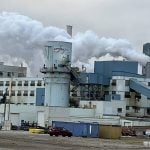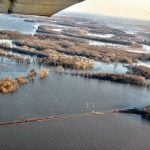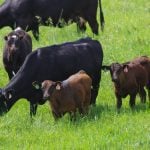Your conversation starts with a text on your device:
FARMER: “Farmbot, please make me a prescription map.”
BOT REPLIES TO FARMER VIA TEXT: Would you like to do variable rate seeding on field 10?
FARMER: Seed costs are higher, so yes.
BOT: Would you like me to produce a rate map for you?
FARMER: Yes.
The Bot provides the map in seconds. Farmer looks at the map and sees a low topography area where the bot anticipates low yield.
FARMER: Why do you expect lower yield in the top right section of the field?
BOT: The soil EC measurements you took last fall showed signs of salinity in that part of the field. I have ensured that all areas in the field with high salinity are receiving lower seed rate.
FARMER: Okay.
BOT: Should I send this map to the seeding tool?
FARMER: Yes, send it to the airseeder monitor in tractor S.
BOT: Done.
This is the future. The farm’s central computer has all the farm data. It also scans seed performance comparisons, product labels and scientific papers in milliseconds. Artificial intelligence (AI), using powerful algorithms, synthesizes the data and makes recommendations on inputs to apply, including when, where and at what rates. Through regular communication, the computer learns the farmer’s preferences. Farmers make all final decisions.
Read Also

The wildly adaptable side of next gen agriculture
Some people just fall into the world of agriculture — and consider themselves lucky to have stumbled into such a…
“The bottleneck right now is that farmers have data but don’t necessarily know what it means. They often need a specialist to figure it out,” says Felippe Karp, a PhD candidate from McGill University doing fieldwork at Olds College of Agriculture & Technology.
Through a McGill, Telus and Olds College joint project, Karp is studying how to bring together multiple layers of farm data to support agricultural decision-making. “Having data from all commercially available sensors might not be practical for an individual farm,” Karp says. “One of the goals of this research is to identify which layers of data are most important to farm decision-making.”
Once researchers like Karp figure out what sensors and data are most useful, the AI platform would take over. Using farm data from these sensors as well as soil analysis, topography, combine yield maps, historical records on crop rotation, products applied, weather, and costs for labour and machinery operation, the AI platform will help farmers manage for higher profits per acre, lower emissions, less labour per bushel — whatever goals the farm may have.
This is easy to write about, but not so easy to do.
A dose of reality
“There is a lot of road kill in precision agriculture,” says Bruce J. Erickson, clinical professor of digital agriculture in the department of agronomy at Purdue University. “I’m almost 64 and I’ve seen all the crashes.”
Applications easy to adopt and with clear benefits tend to avoid the crash-and-burn. Guidance and on-off section control are good examples. Variable rate technology is one application mired somewhat in a data impasse. Interest in variable rate application of fertilizer, seed and pesticides has levelled off, according to the most recent Purdue and Croplife Precision Agriculture Dealership Survey. “Precision farming to manage zones turned out to be a lot more complicated than people realized,” says Erickson, who manages the survey.
Will AI remove the complication and attract more farmers to zone management of inputs?
Erickson is hopeful, but realistic. “AI has supposedly been around since the 1950s. Appearance of ChatGPT seemed to tip the public’s recognition of AI, and now it’s on every news show,” he says. “Is it a fad or trend?”
Trend is more likely, but a trend that takes time to become fully and permanently ingrained. Less disco. More mobile phone.
Raj Khosla, professor of precision agriculture and head of the agronomy department at Kansas State University, says the immense volume of data is only part of the challenge in mobilizing the AI trend.
Data quality is sometimes in question. Take combine yield monitors. Khosla wonders how many farmers find time to calibrate their monitors prior to harvesting. He also notes that yield monitors have a six- to 16-second entrance and exit lag between where the harvest happens to where the data is plotted. Without correction, it makes for nebulous yield zones.
Data is messy. “Data is not organized and not standardized. Currently, we have a limited repository of data in public domain. And that data is too fragmented,” Khosla says. It comes from various sources — many of them private companies. Companies and farmers hesitate to share.
“AI value depends on how well you train the machine, and issues with current data create a major conundrum for training the models,” Khosla says.
The training itself will be hard enough, even when all the data is sound and held in a common repository. “Farmers make decisions by interpreting all that they have known about farming. Likewise, we need to expose the machine to millions of iterations to integrate anomalies and translate that into information,” Khosla says. “Biology, chemistry, physics, economics, technology, social science and psychology all influence such problems and all at the same time.”
Khosla’s lab has been working on enhancing nitrogen use efficiency and water use efficiency through variable rate applications for 25 years. He is participating in a new study looking into AI for sustainability in agriculture. The $10 million project, with funding from the United States Department of Agriculture and the National Institute of Food and Agriculture, spans six states, collecting “as much data as possible” over five years. The goal is to identify what makes for consistent good performing areas. “If we don’t understand what the problem is, we can’t train the computer to identify anomalies,” he says.
Accurate and trustworthy AI guidance in farm decisions is still a ways off. “Sure a bot can write a prescription map today. And a four-year-old can draw lines inside a circle and call them management zones,” Khosla says. “I’m excited about the tool, but the notion that AI can solve this today is premature.”
Will we get there eventually? Both Erickson and Khosla say, “Absolutely.”
Closing the gap
Khosla spoke on AI in agriculture in his opening keynote at the 14th European Conference on Precision Agriculture this past summer in Italy. At the end of his presentation, Khosla shared hypothetical conservations between bot and farmer.
FARMER: I don’t think nitrogen side-dress is required.
BOT: Based on previous yield and current nitrogen state, it may reduce yield by 1.2 tonnes per hectare. Would you still not consider applying it?
FARMER: Okay! Then upload the prescription map along with irrigation chart.
BOT: It is now uploaded to precision system. You may actuate or set a reminder.
FARMER: Set a reminder.
Karp attended the conference, and his recollection of the presentation inspired the farmer-bot conversation at the top of this article.
“The likelihood of AI becoming able to estimate outcomes based on 20 years of data is high. But we don’t have that training data,” Khosla says. “We have so many gaps.”
To close the gaps, he says we need to overcome the challenge of “who owns the data.” And we need investment to tap into the wealth of knowledge from institutions.
The challenge has attracted research investment from legacy agribusinesses, startups and big computer companies. Microsoft FarmVibes, for example, is developing technologies for connectivity, data collection, data analysis using AI and data interface through a chatbot. The project goal, as described on the website, is to build affordable digital technologies that help farmers reduce emissions, predict weather variations and choose practices that improve soil health and profitability.
Moving AI from idea to on-farm implementation will depend on new explorers like Felippe Karp. Karp grew up in the Brazilian town of São João da Boa Vista, north of São Paulo. The farming region produces cattle, coffee, citrus, corn, soybeans and vegetables. While Karp has grandparents who farmed, his father managed the town’s Department of Environment, Agriculture and Supply. His uncle ran an electronics repair shop. Karp was fascinated by the circuit boards and technology. He studied agronomic engineering at the University of São Paulo’s Luiz de Queiroz College of Agriculture, and joined an extracurricular group that explored precision agriculture tools. “The group’s vision is that ‘precision agriculture’ would just become agriculture,” Karp says. “Data would be part of the job of farming.”
The goal is to help farmers reduce risk. Companies in other sectors already use data to manage inventory, run target marketing and design content specific to each user. But agriculture is different. “Plants are biological organisms,” says Bruce Erickson. “They don’t always do what we think they’re going to do.” Then you add in the weather.
“We can’t predict exactly what will happen, but we can use past data to guide decisions based on probabilities,” Karp says. “Will it be right all of the time? No. But if farmers had a choice between 60 per cent chance of being right and a 20 per cent chance, they will go with the 60 per cent chance.”
With AI to help farmers synthesize high quality data from the most appropriate sources, Karp says, “farmers won’t have to guess any more.”
FARMER: Thank you.
BOT: You’re welcome.















